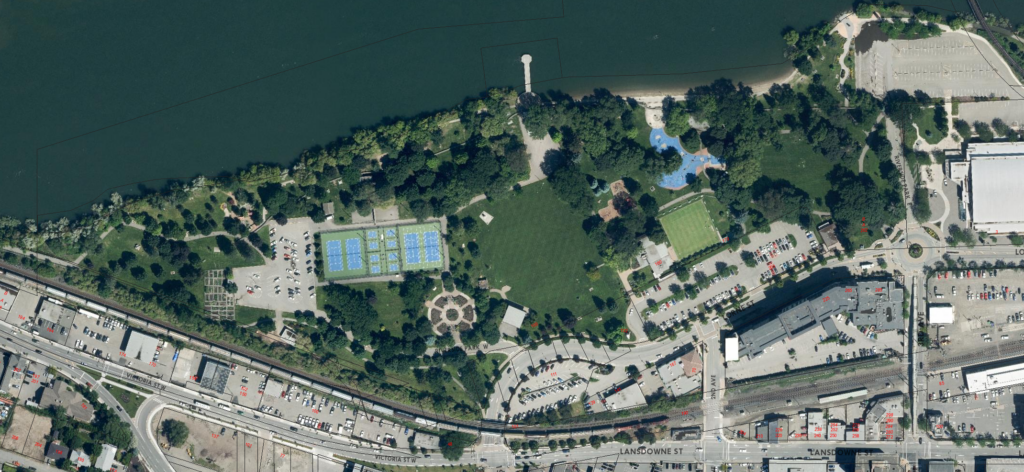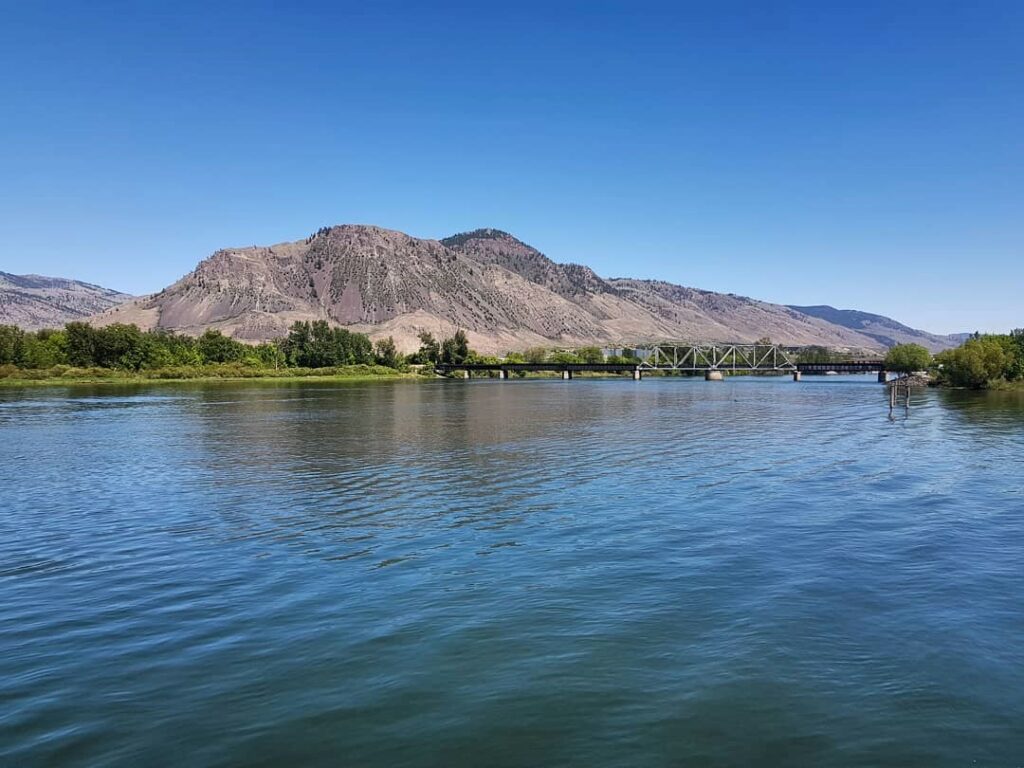7 Riverside Park
Abubakar, Leila
Introduction
Urban parks are green spaces that provide a vital and essential service as population and urbanization continue to proliferate; more than 50% of the world population currently resides in urban areas, with a projected increase to 68% in 2050 (Ritchie & Roser, 2018). This continuous change in the urban makeup will put added pressure on existing urban parks, which will need to be resourced and enhanced effectively to continue offering the necessary provisions to society. The Riverside Park occupies a prime land area in downtown Kamloops Valuation of the Park puts a monetary value on the park, providing a better tool to policymakers when deciding the importance of urban parks and how resources should be allocated. This paper aims to estimate the value of green infrastructure and ecosystem services of Riverside Park using the Benefit Transfer Method (BTM).
Established in 1902 as Kamloops’s premier city park, Riverside Park is located in the City of Kamloops south of the Thompson River and north of the city’s downtown core; it is twenty-five hectares in size spanning from above 3rd Avenue on the right to where Victoria Street joins the riverbank on the left. (Menard, 2006). Figure 1 below is a satellite image of Riverside Park showcasing the Thompson River, the beach, some of the available activity facilities, and the adjacent landscape. The park provides a wide array of amenities that includes a water park, picket ball, and tennis courts, and its most notable is the Rivers Trail that runs along the entire northern edge of the Riverside Park to Pioneer Park along Waterfront Park, allowing for both walking/running or cycling and Public beach access (Menard, 2006).

The city of Kamloops has done a commendable job of creating an exceptional park system in Kamloops preserving green spaces within the city of Kamloops in a diverse and sustainable fashion that has created an interconnected, inclusive, and accessible park system that provides an avenue for healthy, active living for residents and visitors of the city of Kamloops (Oasis of Activity: City of Kamloops, Parks Masterplan, 2013).

Methodology
To estimate the value of the park and the ecosystem services derived from Riverside Park, the Benefit Transfer Method (BTM) used by Sutton and Anderson (2016) to assess the Value of NYC Central Park will be used. The data for the analysis were retrieved from BC Assessment (2022) for 22 commercial and residential properties adjacent to Riverside Park. The land values of the data set were converted to hectares and averaged to get a unit price which was then multiplied by 10.51 hectares, the size of Riverside Park (Kamloops, C. of, n.d), to determine the park’s estimated value.
Results
Table 1 below shows data collected from BC Assessment (2022) on land value, building value, and the year it was built; the average land value is $428,857 on an average lot of 0.0992. Land values range from $126,000 to $1,045,000. 75% of the land values are less than $540,000. The majority of the properties adjacent to Riverside Park are commercial properties due to its proximity to Kamloops downtown area; out of 22 land values collected, 13 were commercial properties, 4 were residential properties,3 were vacant land, and 2 were residential were parking lots spaces. The mean (average) land value of one hectare of land adjacent the Riverside Park is $5,445,798. Riverside Park occupies 10.5 hectares of land; using the average value of properties close to the park to determine Riverside Park’s estimated value would value the land the park sits on at $57,180,879. Ecosystem Services Valuation Database (ESVD) values the ecosystem services for Urban parks and forests at USD 100,000 per hectare annually or CDN $125,000 at the current exchange rate; using this estimate would value the ecosystem services provided by Riverside Park at $1,312,500 annually or an annual yield of 2.3%. Using the Sutton and Anderson (2016) 5% yield, the ecosystem services would be estimated at $2,859,094 per year.
Table 1: Descriptive Statistics of 22 properties adjacent to Riverside Park
| Variable | Mean | StDev | Minimum | Q1 | Median | Q3 | Maximum |
|---|---|---|---|---|---|---|---|
| Land Value | 428,857 | 250,125 | 126,000 | 245,000 | 361,000 | 540,000 | 1,045,000 |
| Building Value | 764,092 | 1,250,550 | 77,200 | 233,000 | 305,000 | 628,000 | 4,801,000 |
| Year Built | 1950 | 35 | 1901 | 1912 | 1958 | 1977 | 1996 |
| Size (in Ha) | 0.0992 | 0.0786 | 0.0223 | 0.0409 | 0.0628 | 0.1628 | 0.2608 |
| Land Value per Ha | 5,445,798 | 1,943,463 | 1,560,541 | 3,777,993 | 5,691,820 | 6,698,517 | 8,780,647 |
Discussion and Conclusion
Urban Parks such as Riverside Park plays a vital role in the lives of urban dwellers, and the city of Kamloops recognizes its importance and listed the following as the goals of its parks (Menard, 2006)
- Ensure citizens of Kamloops have adequate opportunities for personal growth in leisure.
- Protect, preserve, and enhance the environment for the enrichment of the community
- Ensure public parklands are distributed equitably throughout the community.
- Develop and maintain an aesthetically appealing environment.
- Support the development of a strong community image.
Urban parks improve local economies and promote job creation by promoting tourism and attracting business ventures. Parks make cities more resilient and attractive, playing an essential role in neighborhood revitalization and reducing criminal activities; they attract visitors from surrounding areas and allow engaging activities (Park & Kim, 2019). Riverside Park has a robust summer festival that attracts visitors from all over. Bryant Park in New York City was known for high crime rates until the renovation of the park saw it attract 20,000 visitors daily, and rent for nearby commercial properties increased by 115-225% (Park & Kim, 2019). Riverside Park provides essential ecosystem services such as providing habitat for many animal species and a wide array of plant species, including over 100 years old trees. The Peter Wing Rose Garden (Menard, 2006) mitigates air pollution and reduces noise (Jiang et al., 2019). Urban Parks have been proven to deliver health and psychological benefits to citizens and visitors by providing a platform for physical activity and relaxation (Jiang et al., 2019). The continual enhancement and maintenance of Riverside Park have value for its residents, at its estimated value of $57,180,879 land value and annual ecosystem benefits in the range of $1,312,500 to $$2,859,094 per year. As more and more people migrate to the cities, developing green infrastructures to promote sustainable communities becomes more critical (Jones et al., 2015). Residents and cities are becoming more conscious of the importance of urban parks in contributing to communities’ economic, environmental, and social welfare. Estimating the monetary values of green infrastructure such as urban parks will further reinforce its importance by communicating their value in a universally understood language; monetary will inform policy and decision-making and prioritize the continual development and maintenance of urban parks such as Riverside Park.
References
ESVD. (n.d.). Retrieved April 10, 2022, from https://www.esvd.net/
Jiang, Y., Huang, G., & Fisher, B. (2019). Air quality, human behaviour and urban park visit: A case study in Beijing. Journal of Cleaner Production, 240, 118000. https://www.sciencedirect.com/science/article/abs/pii/S0959652619328707
Jones, R., Symons, J., & Young, C. (2015). Assessing the Economic Value of Green Infrastructure: Green Paper. https://vuir.vu.edu.au/32085/1/assessing-economics-gi-green-paper-visesccwp24.pdf
Kamloops, C. of. (n.d.). Property information report. 100 LORNE ST – Kamloops Property Report. Retrieved April 13, 2022, from https://maps.kamloops.ca/PropertyReports/htmlpages/P10135.html
Menard, E. P. M. (2006). Confluence: a masterplan for Riverside Park (Doctoral dissertation, University of British Columbia).
Oasis of activity city of Kamloops parks Master Plan. (2013). Retrieved March 14, 2022, from https://www.kamloops.ca/sites/default/files/docs/city-hall/parksmasterplan.pdf
Park, J., & Kim, J. (2019). Economic impacts of a linear urban park on local businesses: The case of Gyeongui Line Forest Park in Seoul. Landscape and Urban Planning, 181, 139-147. https://www.sciencedirect.com/science/article/pii/S0169204618310570
Ritchie, H., & Roser, M. (2018, June 13). Urbanization. Our World in Data. Retrieved April 10, 2022, from https://ourworldindata.org/urbanization

